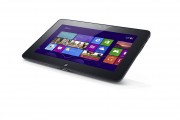The official name for it is “gesture-recognition technology,” but no self-respecting geek would call the process of poking your finger at a computer screen anything but “touchy-feely computing.”The tablet PC, which uses this kind of interface, has been around for a few unremarkable years now, as have those cash registers one sees in sports bars and some restaurants. There was a desktop computer model made by Hewlett-Packard Co. in 1983, called the HP 150, which was one of the first touch-screen machines.
Interest in the touch-screen interface has bubbled up again; Apple introduced the iPhone a couple of weeks ago, dumping the slender stylus in favour of the fleshy fingertip; in late May, Microsoft announced that in the fall it will release Surface, basically a computer masquerading as a coffee table that uses a 30-inch touch-screen. However, HP has jumped into the lead in the PC world, at least, of this revived metaphor with the TouchSmart IQ770 PC.
The TouchSmart is the product of a joint effort between HP and Microsoft, with HP creating the kind of machine that could exploit all the multimedia features of the Windows Vista Home Premium operating system, released in January. Add to that a 19-inch wide-screen monitor capable of responding to the slap and tickle required to run myriad applications, and you’ve got the smartest multimedia home theatre centre on the market.
Not only can you poke at commands on the screen, use the mouse or the included remote-control device to operate it, but also you can even chatter at it, via Vista’s voice recognition software and HP’s built-in microphone. Talk about communication. You can even poke at it with a stick, although for that, HP would prefer you to use its plastic stylus, which looks like a cartoon of a blunt pencil.
The TouchSmart’s monitor is mounted on a stand that is actually part of the computer, and under the angle of the monitor stand is a space for an HP photo printer.
The TouchSmart is not a powerhouse computer; it can’t crunch very large numbers, edit professional videos or play the more extreme computer games. But then the TouchSmart is designed more for convenience and ease of use: Its performance is only average compared with similarly priced systems, but well enough suited to a market HP says favours tech-savvy mothers and their student children.
One drawback to the sleek design is that the TouchSmart is built in a box only slightly larger than a hefty laptop, and people who like to tinker with their computers will be frustrated. It’s not an issue now, but might be in two or three years’ time, when technological advances will start demanding upgrades.
The TouchSmart screen works well as a navigation tool, though it’s not something you’d want to use too much sitting at your desk – try to play solitaire on it using a finger, and it’s surprising how soon your arm gets sore waving it around like that.
Some people will prefer to use a mouse (the TouchSmart’s included basic wireless laser mouse is very responsive), while others will find themselves more comfortable stroking and petting the screen, depending on tastes and applications. (Finger-painting, anyone? This computer just cries out for Corel Painter.) The keyboard is a little disappointing, however, reflecting the smaller role it plays on a touch-screen machine. It’s small – too small, in fact, with the keys being cramped together – and the arrow keys are not sufficiently distinguished from the others; they’re too close to the numerical keypad, so you can find yourself typing a long string of zeroes if you’re not careful.
But there is one thing that’s cool about the keyboard – there’s a slot under the computer into which the keyboard slips completely when not in use.
The computer market certainly hasn’t indicated it will be wild for touch-sensitive screens – it has been very cool to the tablet PC – so it’s far too soon to predict the popularity of the HP TouchSmart.
But the TouchSmart is handsome, acts as a conversation piece and has obviously been designed with a great deal of thought and consideration to detail. HP’s clear intention is to move it from a desk and put it in a kitchen, a living room or an entertainment room, a move computer makers have been trying to make for years. And if there is a machine that can do it, the TouchSmart is it.
Certainly Apple and Microsoft, with their gesture-recognition devices, are also betting that touchy-feely computing will help them do that too.
Via: TheGlobeAndMail.com


